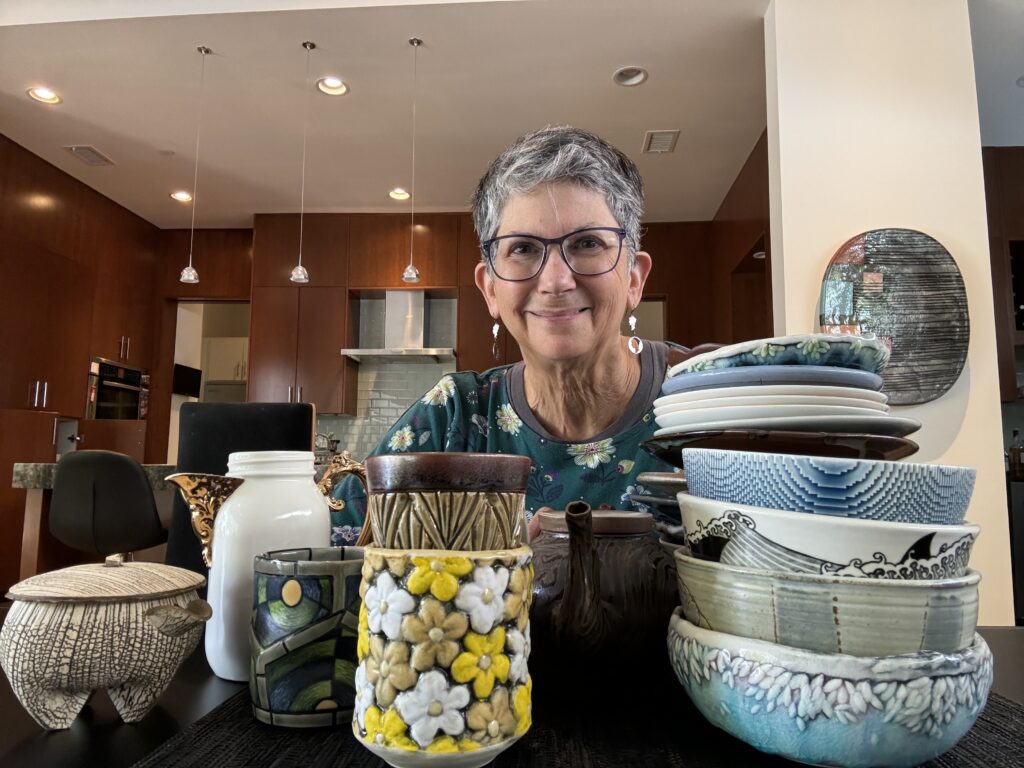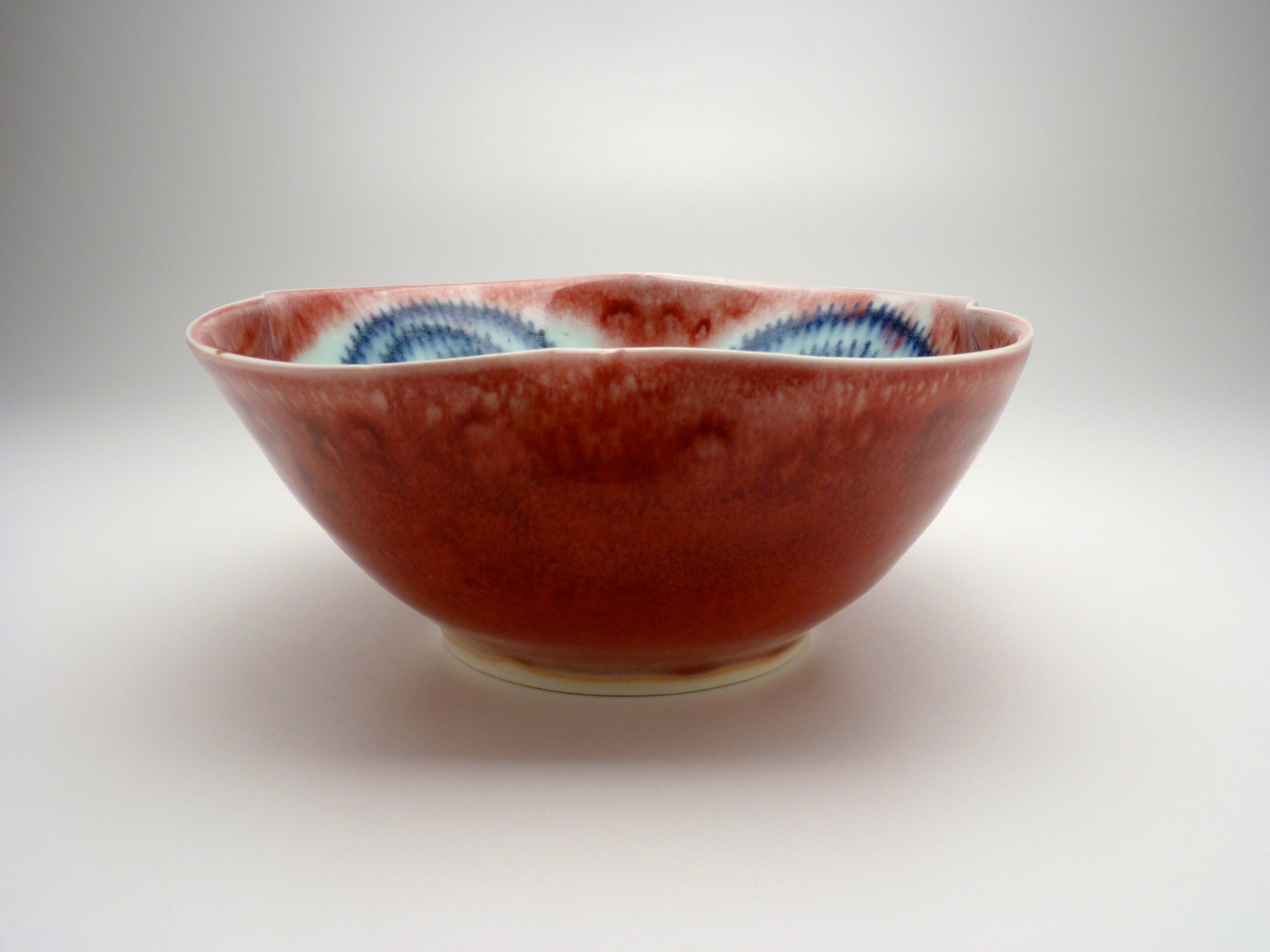Meet Louise Rosenfield, the visionary behind our new café, Louise. A Dallas-based potter and Everson Trustee, Louise has dedicated her life to collecting functional ceramics. With over 3,000 pieces from over 500 contemporary artists in her collection, she dreamed of a place where her collection of works could be used and enjoyed daily.
Thanks to Louise’s generous donation to the Everson, the public is now able enjoy these ceramics through a hands-on dining experience where, by simply tapping your phone to the bottom of the ceramic piece that your food is plated on, you can learn more about the artist who created it.
We spoke with Louise about her history with ceramics, collecting, and her work as a potter.
Q: Why do you collect and when did you first start collecting?
A: All potters are collectors. Ask any maker and you will discover that they each have a collection. I’m an artsy-crafty person. I knit and crochet. I quilt. I paint and draw a little. I love art supplies. I took one clay class in college as an elective. When my son, Ben, was three, he saw a physical therapist because his fine motor skills needed improvement. Two years later, the physical therapist recommended that I get him into a clay class with the idea that manipulating clay would continue to strengthen his motor skills. I hired a potter to come to my house each week to teach a children’s class. Any kid in the neighborhood could bring $5 and participate in the class. The potter let me be the assistant. After a year or so, she asked that we move the class to the local community arts center where she taught other classes to children and adults.
After two more years, my son moved on to other activities, and I was left to take an adult class. At that time, I was an avid hand builder. I started to get discouraged in the adult classes though, because I would work on one piece for maybe four weeks or even more to move it through the process, and then it would come out of the glaze kiln with a hunk of brick on it from a dirty kiln shelf or it would have a crack or some other imperfection. I was just about to quit, but my teacher was moving to another state and had hired a replacement. I felt sorry for the replacement, so I thought I would just sign up for one more class. The new teacher told me that he couldn’t offer much to me unless I learned to throw. I am not coordinated, and it took me months to learn how to center a piece of clay on the wheel and make the crudest bowl, and I became obsessed with clay. My life changed. I started buying pots made by my teacher when he would participate in a sale. That was the beginning of collecting.
Q: Can you tell us about the vision behind the Rosenfield Collection?
A: It wasn’t my vision. After I started buying pots here and there, I began attending the national clay conference known as NCECA (National Conference for Education in the Ceramic Arts). There are so many opportunities to purchase ceramics from all over the world and learn more about the art of ceramics. I also started attending workshops at different locations in the United States where I saw more amazing work and purchased everything that was new and interesting to me. We added shelves in our bar at home to accommodate all the cups. Then we remodeled our kitchen to accommodate all the new plates and bowls. By this time, I probably owned about two or three hundred works, and my husband, David, was really stressed. I helped host a workshop in Dallas, and we went out to dinner with a group of artists who I greatly admire and who David respects as academic colleagues. Toward the end of the dinner, David finally asked, “When is it enough?! When does this collecting stop?! ”
The answer he was given by one of the artists was, “It doesn’t stop, and in fact, you should go even farther! You should document each piece and make it available online!” I was given further inspiration when the same artist showed me a book of Asian ceramics where each piece was shown in several views, and always specifically included the view of the foot. At this time in the early 2000s, if anyone found photos of pots online, it would only be a profile shot, so I immediately decided to include at least three views of each vessel that would include a profile, the foot, and an interior shot. Putting the collection online and making it accessible as a free resource with high quality images was important to me because I recognize that not everyone gets to travel and see as many works as I have, and I think looking at photos of interesting work can be inspirational.
Q: Why is this collection best used in a café setting, rather than on display in a gallery?
A: Early in my clay making history, I heard a lecture about the unseen in our environments. I realized that when a person buys a painting or sculpture, the art is installed in a static location where it can be loved and admired and even improve the ambiance. Viewers use one sense, eyesight, to appreciate the work. After a time however, it recedes to the background, effectively becoming ‘unseen’. In contrast, a plate, bowl, cup, vase, teapot, pitcher, etc., made by an artist who has imbued the same level of story or meaning within the vessel as the artist who created a painting or sculpture, utilizes all the senses. It is touched, seen, heard when pouring liquid or eating with silverware, smelled when used with food or drink or flowers, and tasted, especially with a cup that contacts the lips.
When a person collaborates with a functional vessel, making decisions about what would look best or what would taste best, or what story fits the mood, the actual time spent slowing down and attending to the details to improve the personal experience has been shown to improve mental and physical health by reducing stress and promoting self-care. I realized that functional ceramics used daily would be my focus. I know some people collect functional objects like teapots or salt and pepper shakers to only be viewed. In my opinion, a functional object, not used is a dead object. It is not fulfilling its purpose, which is USE.
Q: You are a potter yourself. Can you tell us about your work?
A: I am a potter. I love playing with clay. Its tactile qualities just seduce me. My ideas for functional work are usually better than my skills, and that doesn’t affect the enjoyment I get from making less than superb work. I like to create work around ideas that are bothering me and by the time I have made a number of vessels about a particular subject, I feel better. I love to use porcelain clay, and I love to decorate the surfaces with color. I also consider myself a closeted pyromaniac, so although it doesn’t provide the exact surface I desire, I love the process of wood firing.
Q: How do you feel your background as an artist has helped shape your approach to collecting?
A: I have always collected work I personally respond to, and not work of someone famous or noteworthy just because it might be available. The collection is a product of my personal taste. I am an extremely picky collector. If I am selecting a work in person, I take time to consider the form, the surface, the weight, the purpose, and if I see even slight imperfections, I will usually pass. This is more difficult when I purchase a work from a photo, and sometimes, when I receive a work that doesn’t quite measure up, I will find another use, rather than add it to the collection. I think my knowledge of ceramics, and especially the processes involved in creating the work have helped me be more refined in my selections.


Louise Rosenfield, Bowl, ceramic, 8 x 8 x 3 inches, Rosenfield Collection.

Louise Rosenfield, Plate, ceramic, 9 x 9 x 1 inches, Rosenfield Collection.

Louise Rosenfield, Vase, ceramic, 7 x 2 x 12 inches, Rosenfield Collection.


